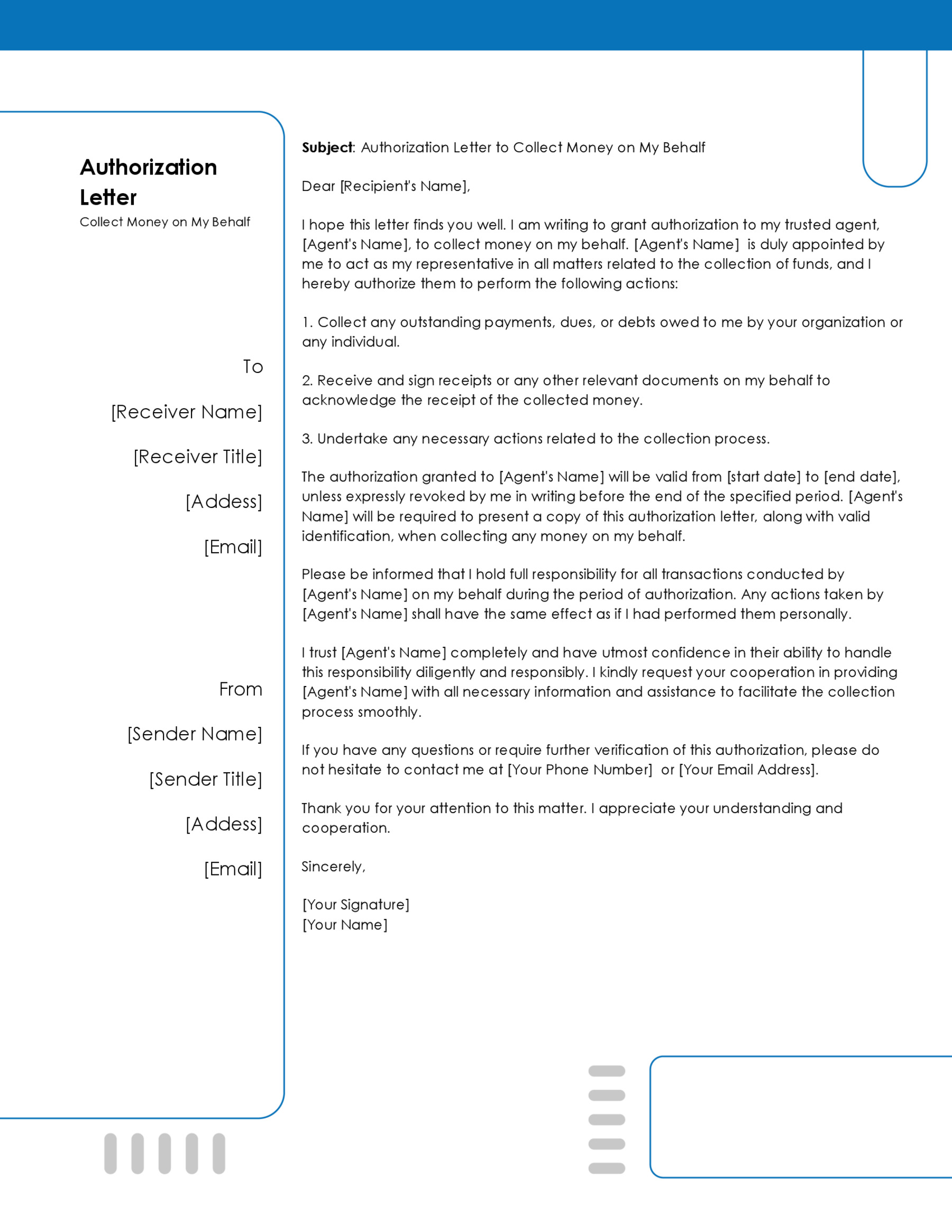An Employee Warning Letter is a formal cautionary document that is usually sent by a human resource manager to an employee informing them of a breach of company protocols.
The letter serves to inform the employee of their misconduct and details of consequences that may come if they fail to improve themselves.
Organizational managers and human resource personnel should never overlook or tolerate any type of disorderly conduct by employees as it leads to future disciplinary problems and dissatisfaction among other employees. Different organizations have different policies that dictate how disciplinary action against employee misconduct should be addressed, but the first step that any organization generally takes is a verbal warning for minor infractions.
However, when verbal communications between the supervisor and the employee do not lead to a change of behavior, a formal letter is necessary as it is more effective in stopping any further misconduct or breach of company rules. Unlike a verbal one, employees can see and reply to a written warning; thus, managers can record the employee’s performance.
Warning letters to employees can also be referred to using the following names:
- Employee warning notice
- Letter of reprimand
- Disciplinary form
- Written warning notice
Free Downloads
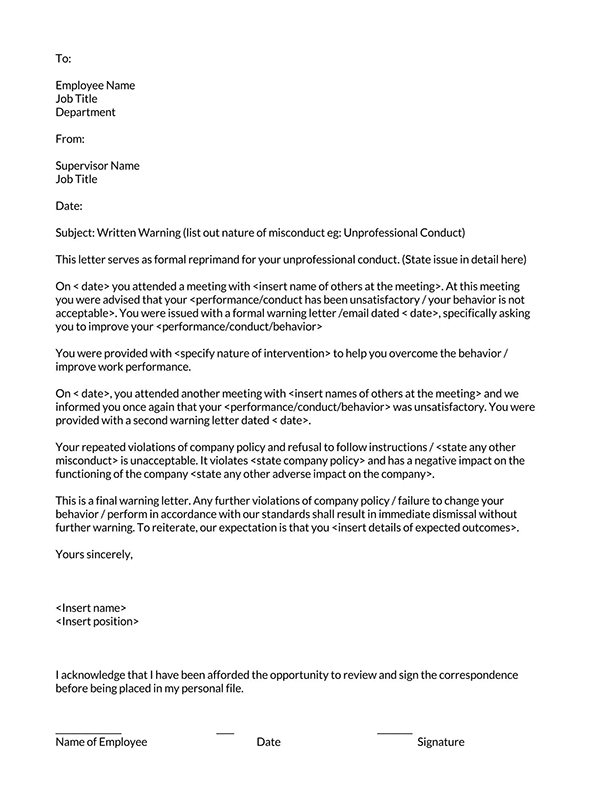
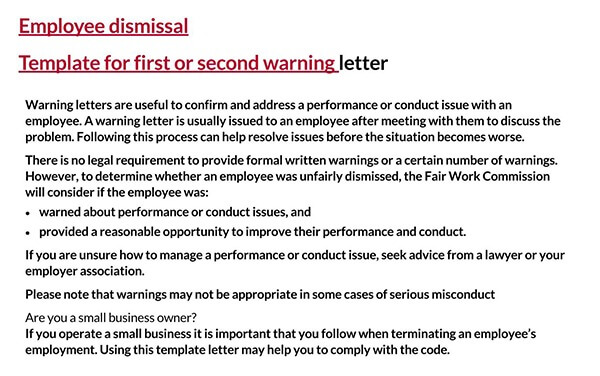
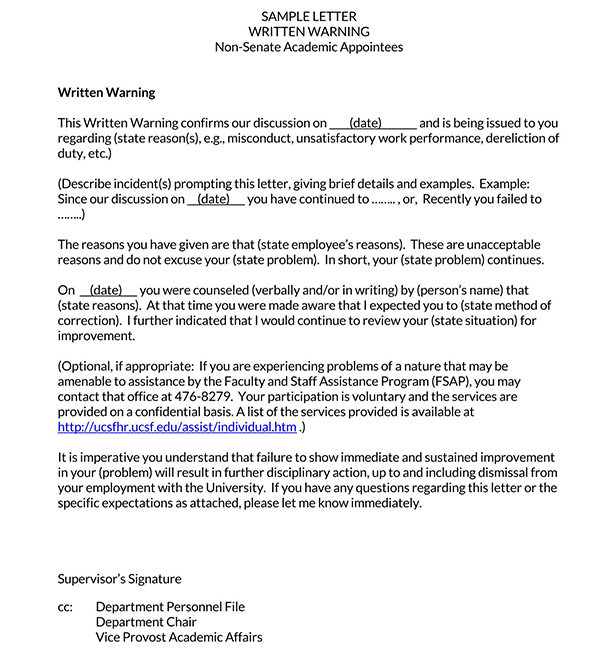
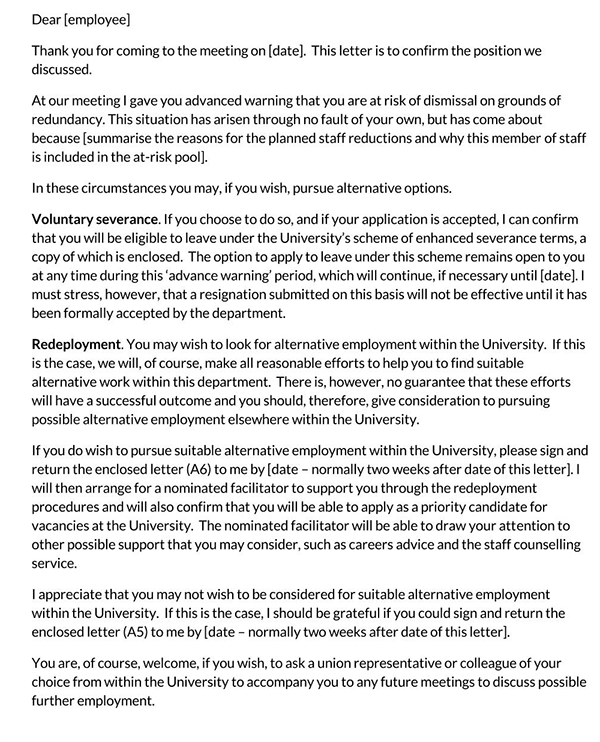
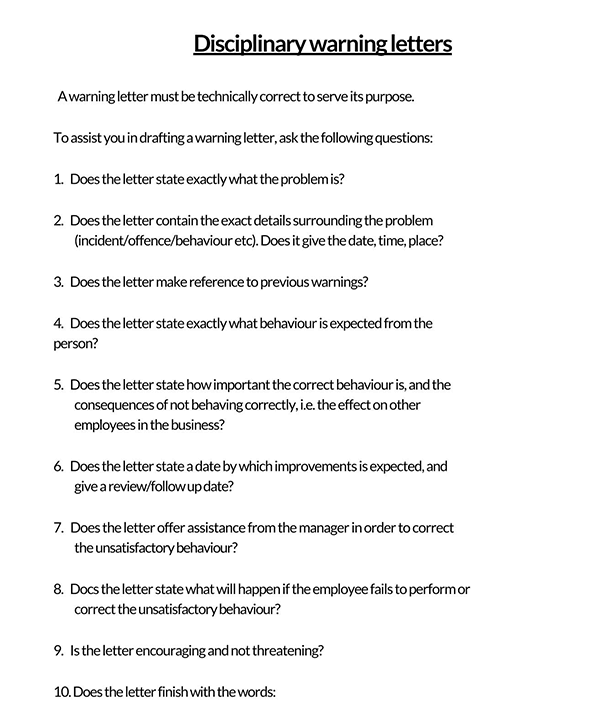
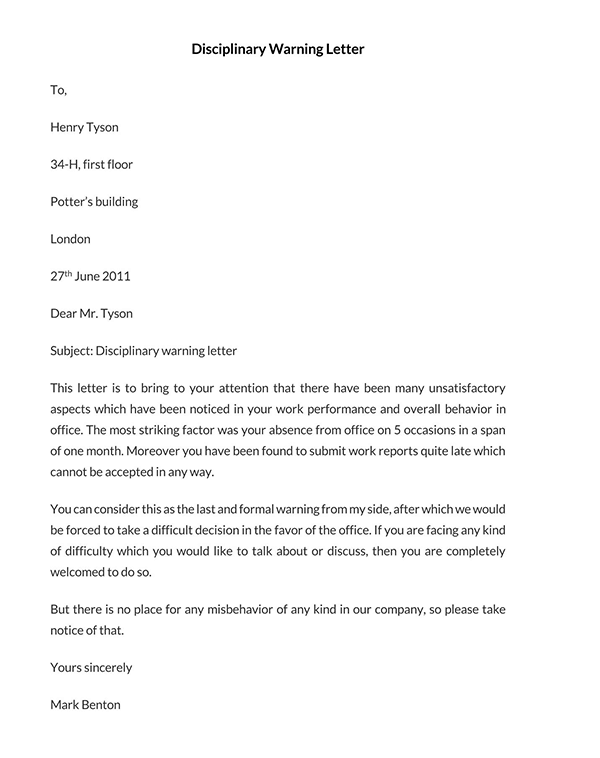
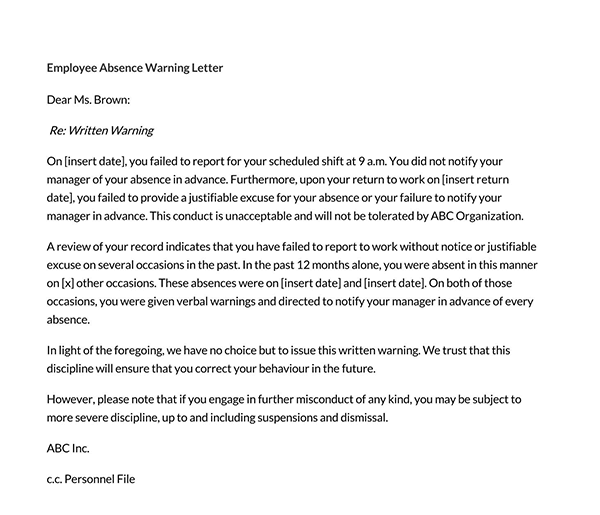
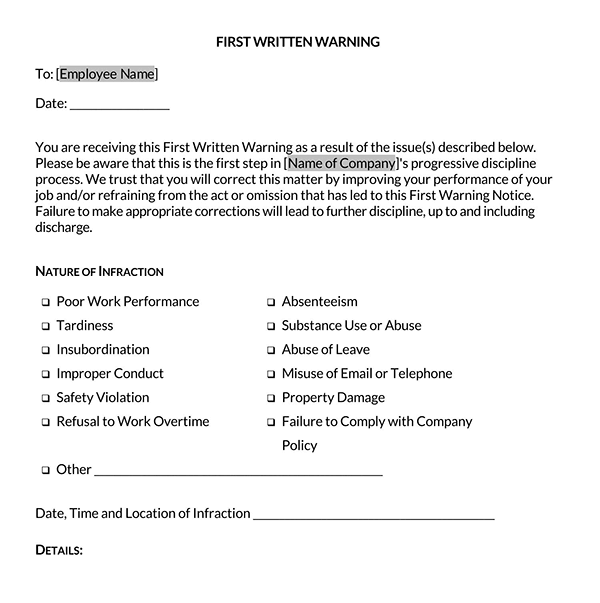
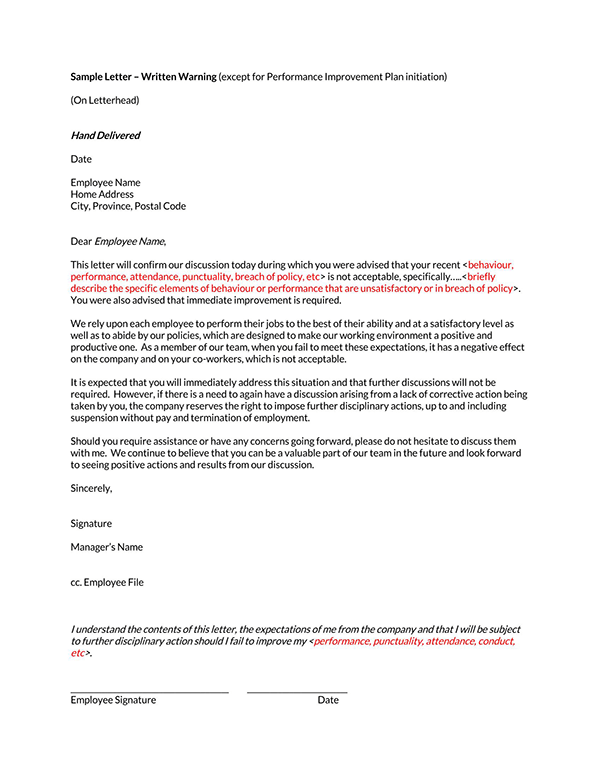
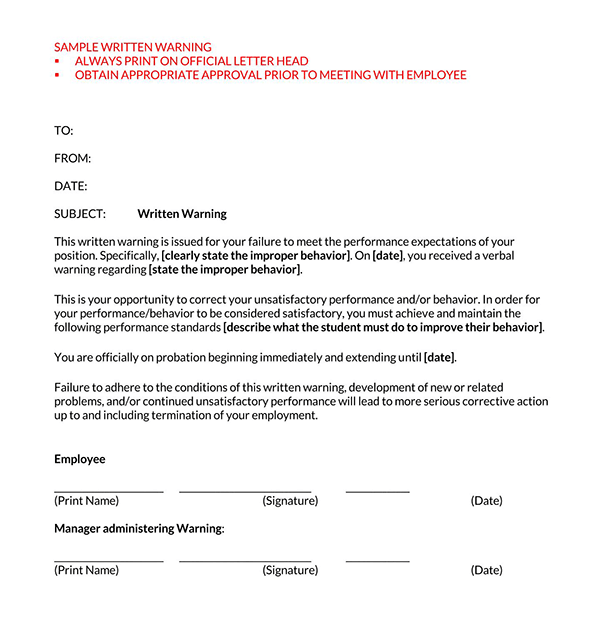
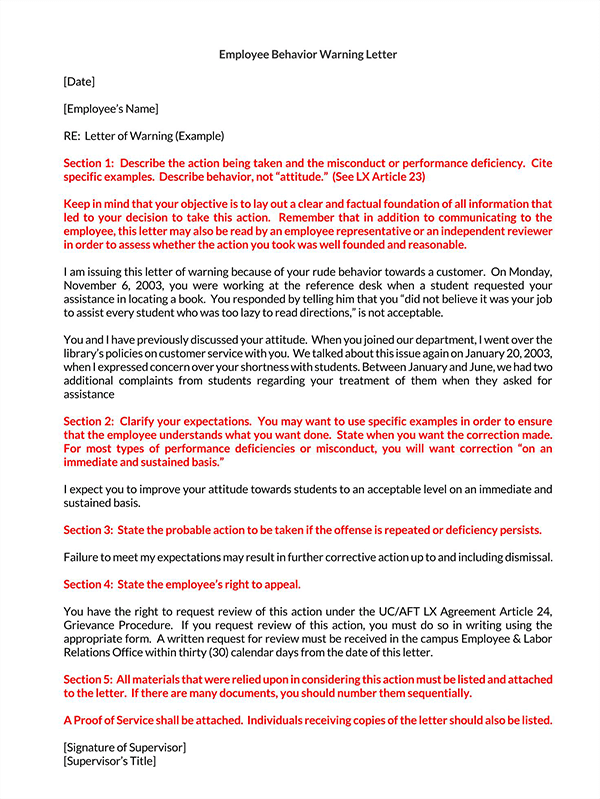
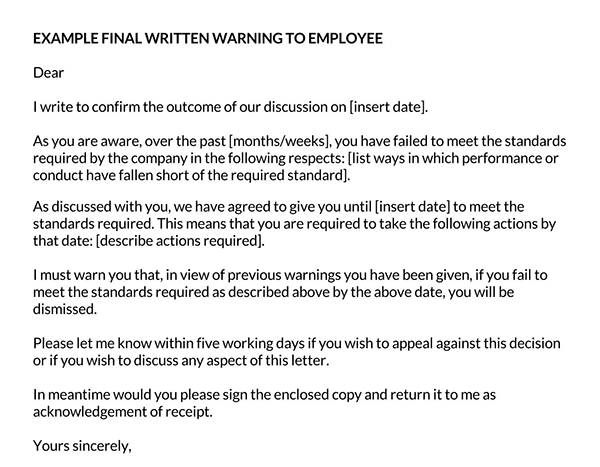
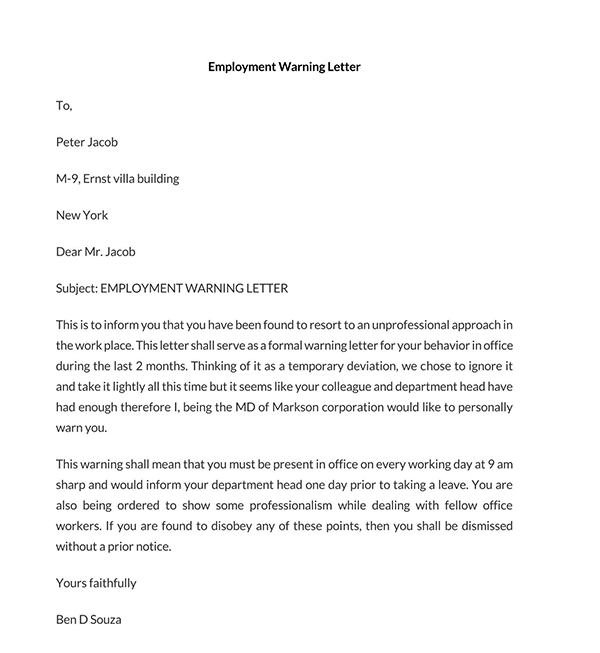
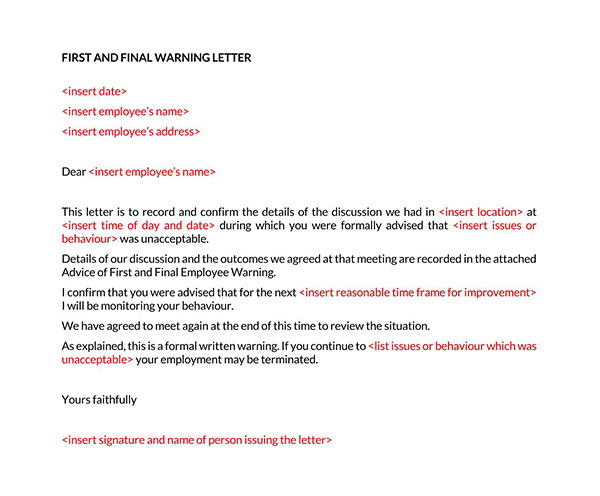
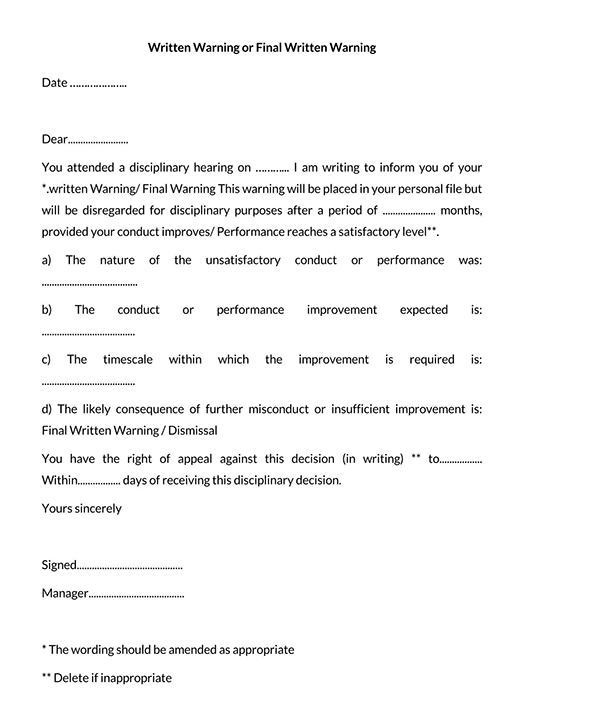
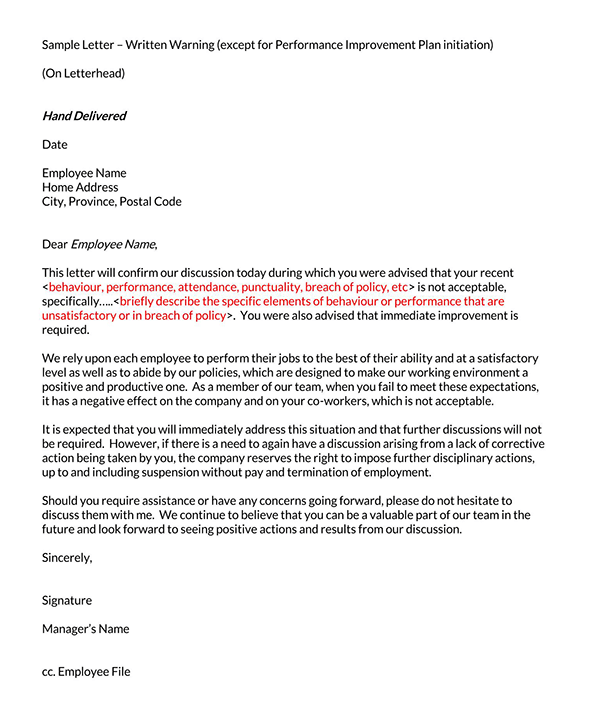
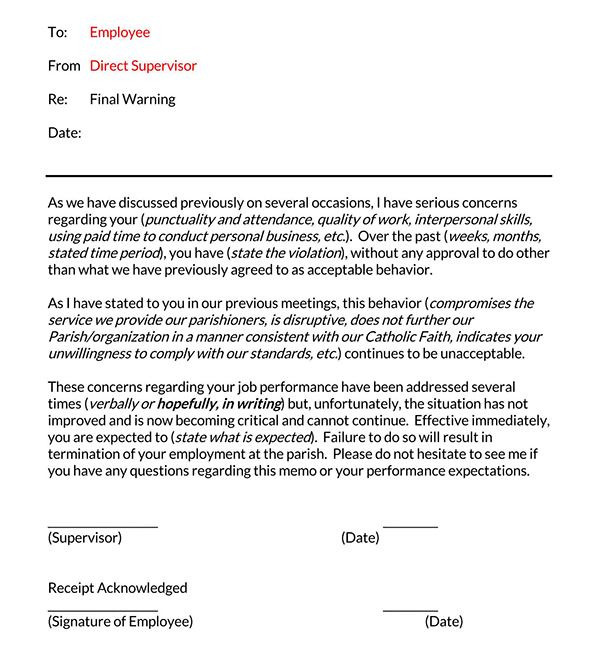
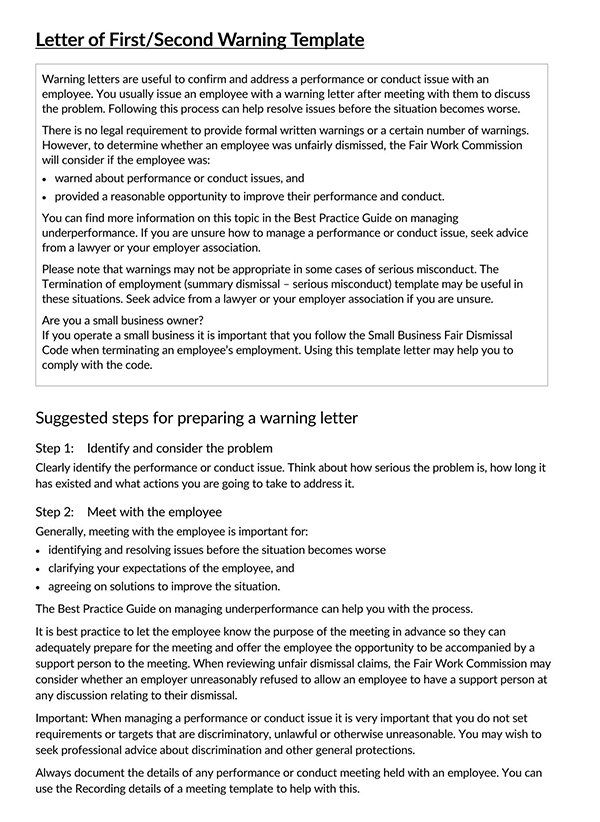
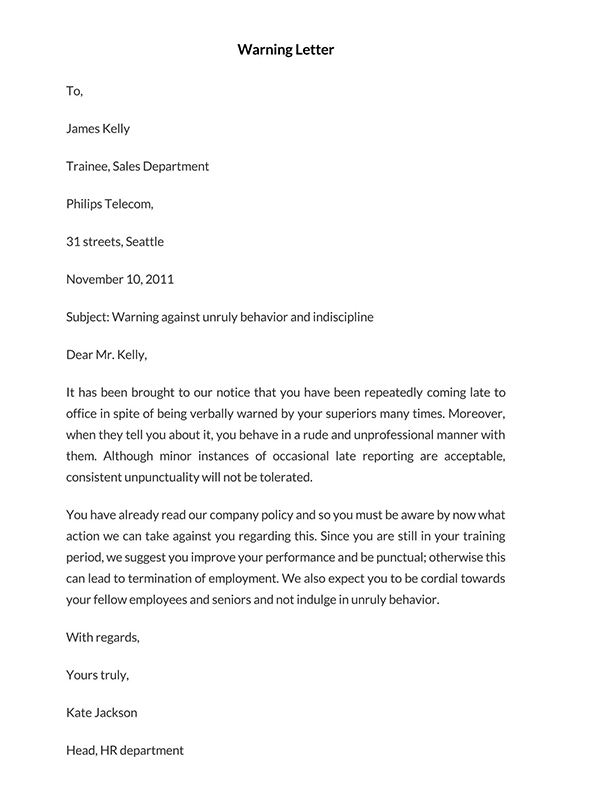
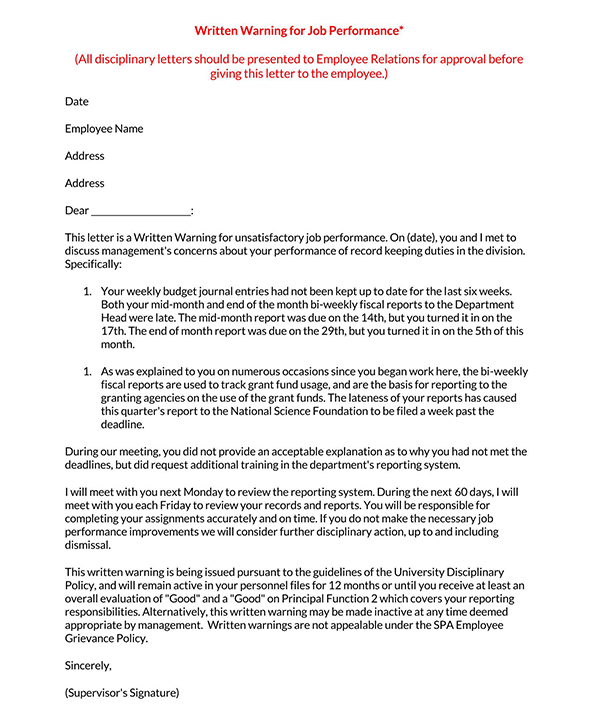
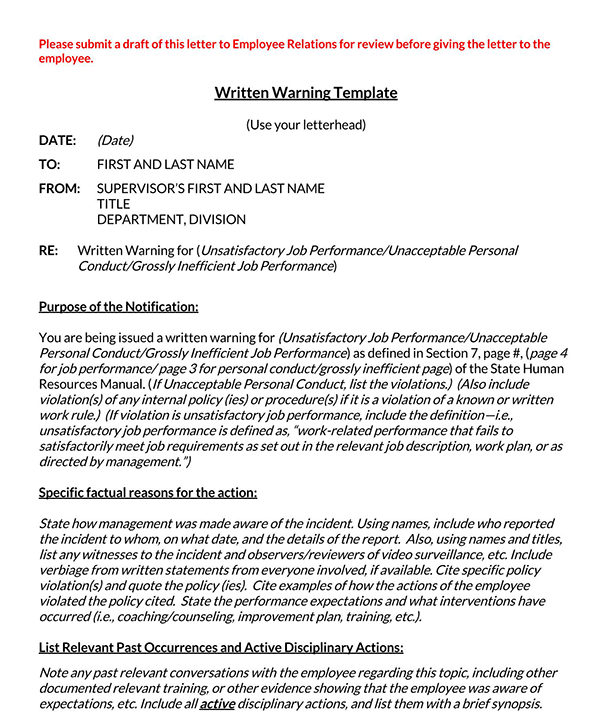
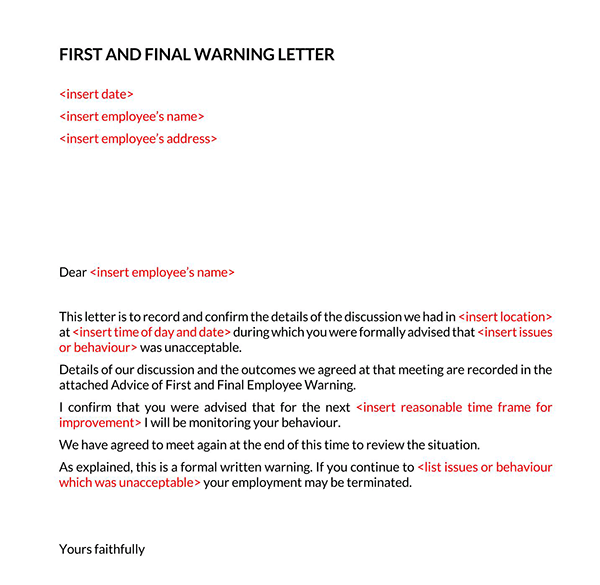
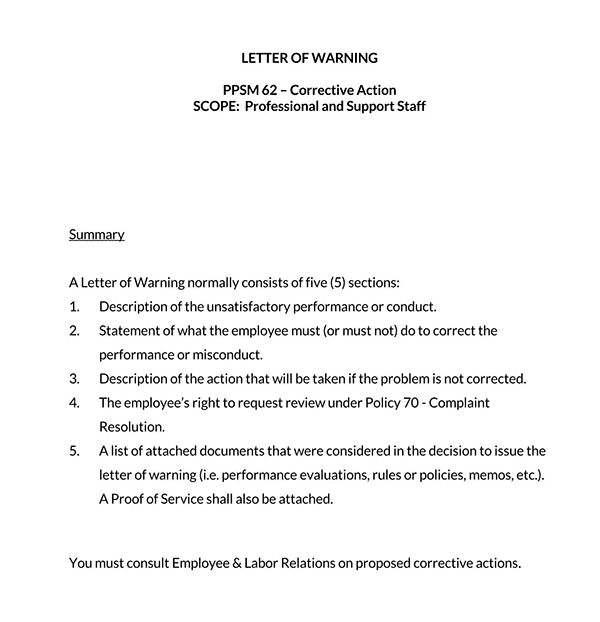
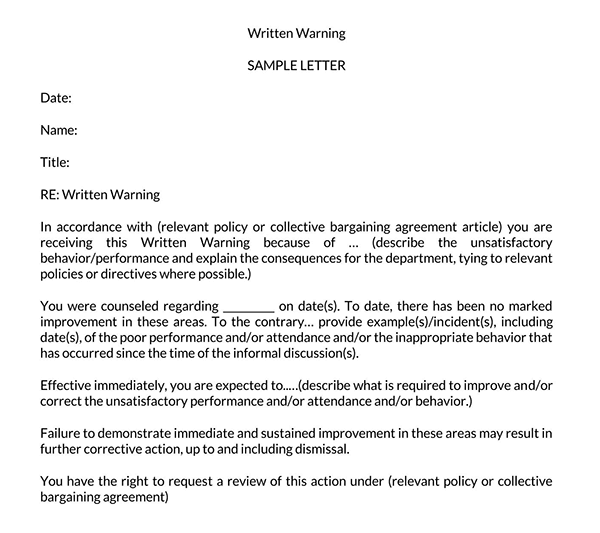
Importance of the Letter
This letter is an essential formal communication mechanism that allows company managers to take corrective action against employees’ underperformance, regular absenteeism, or general misconduct at work.
The letter is important due to the following reasons:
- A letter is a record that is usually documented in the employee’s personnel file for future reference. The documented form highlights performance or misconduct issues and an action plan for the employee to improve. This ensures that the employee understands the seriousness of the matter and strives to improve.
- Written warnings help set expectations for future behavior, and storing them in the employee’s file allows for easy retrieval if the employee fails to meet the expected improvement standards.
- A formal letter to an employee can also be used legally if termination or other legal action must be carried out. Without the letter, it can be very difficult to defend your organization against an unfair dismissal claim.
Common Reasons to Issue It
Several reasons may necessitate an employer to put employees on notice using letters.
This includes:
Due to excessive absence and lateness
In a normal workplace setting, employees will generally get sick or have emergencies that may warrant their absence from work from time to time. However, when a staff member is constantly absent from work or late, the manager may need to issue them an attendance warning letter. This is especially true when the employee’s absence affects their productivity or when the attendance issues are affecting the organization’s productivity goals.
If an employee fails to meet the job requirements
If an employee fails to meet the job requirements or produces substandard work, issuing them a written letter that highlights the performance concerns is acceptable. Common examples of poor performance include too many mistakes, an inability to follow the job guidelines, and missed deadlines.
Breaching any type of policies
In instances where employees pose safety risks by disregarding health and safety regulations, call for letters highlighting the safety violations. This is because disregarding such regulations could be perilous to the business, and immediate disciplinary action must be taken against those employees to avoid future safety issues within the workplace.
Disregarding company policies, such as drug and alcohol abuse at the workplace or breaches of the confidentiality clause by company employees, also warrants issuing such letters.
Deliberate falsification of records
If an employee deliberately falsifies documents or records to mislead the employer, issuing them a warning letter is considered standard practice. However, this is considered gross misconduct in most cases, leading to immediate termination without notice.
Stealing from the business
Stealing from the business or a co-worker is categorized as gross misconduct for most organizational policies. An employer may decide to issue the employee a letter notifying them of the consequences of their behavior, including suspension from work or immediate termination.
Verbal or physical official violence
When an employee threatens to physically harm another employee or is generally rude or disruptive to co-workers, a formal letter is considered an acceptable corrective action measure.
How to Issue It
Handing out such letters is an unpleasant experience, but they are a necessity as they ensure employees know what is expected of them and what is considered unacceptable conduct.
The following is a guide on how to issue such letters to employees to make the process smoother and ensure it has the desired impact:
Step 1- Notify the employee beforehand
You can send a written warning through traditional mail or via email, but either way, you should have the employee’s immediate supervisor or line manager notify him/her beforehand. You may follow up with a phone call to emphasize the seriousness of the breach.
Step 2- Schedule a face-to-face meeting
Set up a convenient time and location where you can meet with the employee and discuss the matter beforehand. In most cases, the letter is usually issued at the meeting with a third party, such as a human resources representative present. It is essential that you set up the meeting in a formal setting such as the company’s designated meeting room, your office, or a supervisor’s cabin rather than in informal settings such as restaurants or cafeterias.
Step 3- Inform the employee of the reason for the meeting
Start the meeting by informing the employee why you have set up the meeting. Then proceed to discuss the issue at hand with the employee, citing specific areas of concern. It is recommended to prepare early to have in-depth details of your concerns, as the employee will often try to justify their behavior. It is also worthwhile to go over the allegations point by point and take time to let the employee react.
Step 4- Set clear expectations
Once you have raised the employee’s infractions, discuss the specific outcomes expected from them and provide a specific timeframe for improvement. The employee should walk out of the meeting room knowing exactly what they need to do and the consequences of failing to improve as expected.
Step 5- Make the discussion conversational
It is crucial that you make the meeting conversational rather than one-way communication to allow the employees to share thoughts on how they can improve going forward. Make sure to document the employee’s thoughts on the company copy of the letter.
Step 6- Sign the letter
All three parties—the employee, the HR representative, and the manager—should sign the letter at the meeting. In some cases, the employee might refuse to sign the letter. In such cases, the manager and the HR representative should go ahead and sign the document, and then the employee’s reasons for refusing to sign it should be noted down.
Step 7- Making copies
Issue the employee the original copy of the letter and file a copy of the signed document in the employee’s employment file. This step is important for future reference if any legal action needs to be taken or in the event of a lawsuit.
Components of Letter
Generally, it may be helpful for a written employee warning notice to include as much detail as possible to establish clear expectations, provide a timeline and eliminate any guesswork for anyone reviewing the employee’s personnel file in the future.
As such, the letter should incorporate the following information:
- The letter should include company details such as the name of the organization, the manager’s name, and position in the organization, as well as the name of the human resource representative if applicable
- The date of the warning
- The employment details of the employee, including their name, job title/position, and their payroll or employee number
- The level or type of discipline, for example, a first written warning or a written warning with a three-day suspension
- A detailed description of the infraction the employee is being reprimanded for, as well as a precise date of occurrence
- A list of the previous warnings, including verbal ones and written notices that the employer has issued to the employee and relevant disciplinary actions taken against them.
- A description of the specific policy and procedures that the employee breached
- Corrective action for the employee as well as what is expected from them going forward
- A comment section for employee comments, signing details for all the involved parties, and any other additional information, such as whether a follow-up assessment will be necessary and when.
Sample Letters
To get a better and more clear idea of how to structure and format your letters, review the following sample letters:
Sample Warning Letter for Unacceptable Behavior
Subject: First Written Warning for Unacceptable Behavior
Dear John,
This letter serves as a formal, first written warning regarding your unacceptable behavior in the workplace. On December 10, 20XX, it was reported and subsequently confirmed that you engaged in a verbal altercation with a colleague, which is in direct violation of our company’s code of conduct and respect in the workplace policy.
Previously, you received a verbal warning on November 5, 20XX, for similar conduct. This pattern of behavior is concerning and unacceptable in our professional environment.
GreenTech Innovations is committed to maintaining a respectful and safe workplace. Your actions breached our policy on Workplace Harmony and Respect, as outlined in our employee handbook.
As a corrective measure, we expect you to complete an interpersonal skills training course by January 15, 20XX, and demonstrate significant improvements in your interactions with colleagues. Failure to comply or a repetition of this behavior will lead to further disciplinary action, up to and including termination.
You may provide any comments in the space below:
[Employee Comments]
_______________________________________________________________________
Please acknowledge receipt and understanding of this warning by signing below:
Employee Signature: ____________________ Date: ___________
Manager Signature: ______________________ Date: ___________
HR Representative Signature: ______________ Date: ___________
A follow-up assessment will be conducted on February 15, 20XX, to review your progress.
Sample Warning Letter for Habitual Late Attendance
Subject: Written Warning with a Three-Day Suspension for Habitual Late Attendance
Dear Alice,
This letter serves as a written warning accompanied by a three-day suspension due to your habitual late attendance. Our records indicate that you have been late ten times in the past month, most recently on December 12, 20XX. This pattern of tardiness is unacceptable and disrupts our team’s operations.
You have previously received two verbal warnings, on November 10 and November 22, 20XX, regarding this issue. Despite these warnings, there has been no improvement in your punctuality.
As per Dynamic Solutions Inc.’s attendance policy, consistent punctuality is expected from all employees. Your repeated tardiness is a breach of this policy.
Effective immediately, you are suspended for three days, without pay, from December 16 to December 18, 20XX. Upon your return, we expect you to adhere to your scheduled work hours. Further incidents of late attendance will lead to more severe disciplinary actions, including the possibility of termination.
You may provide any comments in the space below:
[Employee Comments]
_______________________________________________________________________
Please acknowledge receipt and understanding of this warning by signing below:
Employee Signature: ____________________ Date: ___________
Manager Signature: ______________________ Date: ___________
HR Representative Signature: ______________ Date: ___________
A follow-up assessment will be conducted on January 15, 20XX, to review your adherence to the expected work hours.
Analysis
The provided sample warning letters serve as excellent templates for formal disciplinary communication in a workplace, exhibiting several key components that contribute to their effectiveness. Firstly, the clarity of the subject lines is commendable, as they immediately inform the recipient about the content and seriousness of the letters. This clarity is further enhanced by the use of formal salutations, which help to maintain the professional tone necessary for such communications. A notable aspect of these letters is the detailed specificity with which the incidents are described, including precise dates and the nature of the misconduct. This level of detail eliminates any ambiguity and conveys to the employee the specific behaviors that are being addressed.
Furthermore, the letters effectively reference past warnings, which is crucial in establishing the context and showing that the disciplinary action is not abrupt but a result of continued unacceptable behavior. This historical context is important for both a legal and personal understanding of the situation. Additionally, by citing the specific company policies that have been violated, the letters reinforce the legitimacy of the disciplinary action and align it with the organization’s established rules and expectations. This not only underscores the seriousness of the issue but also serves as a reminder of the company’s standards.
Another key element is the inclusion of corrective actions and expectations. The letters do not just criticize past behavior but also provide a clear path for improvement, which is essential for constructive disciplinary practices. By outlining the consequences of further violations, the letters set clear expectations and inform the employee of the severity of future non-compliance. This aspect is crucial in ensuring that the employee understands both the immediate and long-term implications of their actions.
The opportunity for the employee to provide comments in the letters is a commendable practice. It allows for a two-way communication process, giving the employee a chance to present their perspective, which is important for maintaining a fair and transparent disciplinary procedure. The requirement for signatures from the employee, manager, and HR representative adds a formal and legal weight to the document, ensuring that all parties are aware of and acknowledge the warning.
Lastly, setting a specific date for a follow-up assessment is a strategic move. It not only provides a clear timeline for expected improvement but also keeps the issue actively monitored, ensuring that it receives the necessary attention moving forward.
In summary, these letters are exemplary in their structured, clear, and fair approach to addressing workplace issues, making them valuable models for similar disciplinary communications.
Letter Template
[Company or business letterhead]
[Current date]
[Receiver’s name]
[Receiver’s job title or position]
[Respective department]
[Receiver’s address]
Dear, [receiver/employee’s name]
According to____________ [site the specific company policy/employment contract],this is a formal warning notice. This action is based on your________________ [insert the performance concerns/unacceptable conduct, policy violations, etc].
On previous occasions, detailed reviews have been made regarding your__________ [Insert the concerns, for example, attendance, performance, general conduct, etc.]so that you understand the requirements of the job and the implications of your conduct. The issues have been discussed verbally on______________ [Insert the specific dates] and in writing____________ [list the written notices issued for example, counselling letter, performance appraisals, emails, etc]. However, you have remained adamant in meeting these expectations.
Your continued failure to follow the basic requirements of your job has had a serious impact on the operations of our________________ [List the areas affected, e.g., the department, customers, co-workers, etc.] affecting our ability to meet corporate goals.
Going forward, you will be expected to______________ [insert what is expected from the employee and include a timeframe]. Failure to meet the laid-out expectations will result in further disciplinary action, including______________ [List the consequences forthcoming including suspension without pay, or loss of employment]
Note that you are free to review the______________ [contract/employment policy] for your appeal rights.
Feel free to contact me__________________ [include details of how the employee can contact you] if you have questions concerning this letter or need clarifications.
Sincerely,
[sender’s name and job title]
[sender’s signature]
Dos and Don’ts
When it comes to drafting employee warning letters, there are certain things that you need to keep in mind to ensure you deliver the message as intended.
The following is a list of the do’s and don’ts of the letters:
Dos
Consider the structure
A warning letter to an employee is an official document, and as is with any formal letter, the letter’s structure should be professionally organized. Organizing the letter logically helps you lay out the details of your concerns more consistently, allowing no room for future misinterpretations.
Go straight to the details
The letters should be simple, precise, and to the point. The identified infractions must be made clear from the start such that the employee does not misinterpret the message. Bringing up other matters may make it hard for the employee to focus on what is important and what they need to do to get back on track. The allegations should be detailed using short sentences, and a professional tone must be maintained throughout the letter to avoid conflicts with the employee.
Mention previous verbal or written notices
If there is a record of previous warnings, include them in the letter if they are fairly recent (preferably within the past 5 years) and somehow related to the conduct in the current discipline.
Include disciplinary action
These letters rarely contain any binding disciplinary action. However, the document should highlight the consequences that may be forthcoming for the employee if they repeat the same mistakes in the future. If any action is taken against the employee as punishment for their disorderly conduct, it should also be detailed in the letter.
Offer a solution
It should not only serve to reprimand the employee for their unacceptable behavior or performance, but it should also include an action plan to help the employee do better down the line. This prevents hostility between the company and the employee, ensuring that both sides benefit from the situation.
Don’ts
Don’t get personal
The letter’s tone should be polite, despite its negative connotation. This is because the letter is mainly written with the intention of helping the employee improve his/her behavior for the smooth functioning of the company. As such, managers should avoid taking a personal approach when writing it or adding an emotional tone to it.
Don’t make baseless claims
While writing the letter, you should focus on the specific wrongdoing and connect the employee’s conduct to the company policies violated. This adds credibility to the notice and helps strengthen the company’s defenses in future litigation. It also helps to ensure policies are not flouted in the future.
Don’t forget to proofread
These are official documents that are usually recorded in the employee’s personnel files. This means that they should be professionally formatted, and proofreading ensures that they have no grammar, spelling, or punctuation errors. Bear in mind that too many grammatical and punctuation mistakes can lead to ambiguity and misinterpretations, making the letter ineffective in dealing with employee behavior or performance concerns.
Ask for the employee’s signature or follow-up
The employee must sign the two copies of the letter to confirm that he/she has received and acknowledged it. If you send the letter via email, request a follow-up proving that the employee has received the message.
Don’t forget to allow an opportunity to provide a written response
Employees have the right to appeal the notices. Therefore, make sure to remind them of this option and provide the necessary contact details. If the employee does submit a response, make sure to review it to determine whether a follow-up is needed. This helps to promote good employee relationships.
Letter Examples
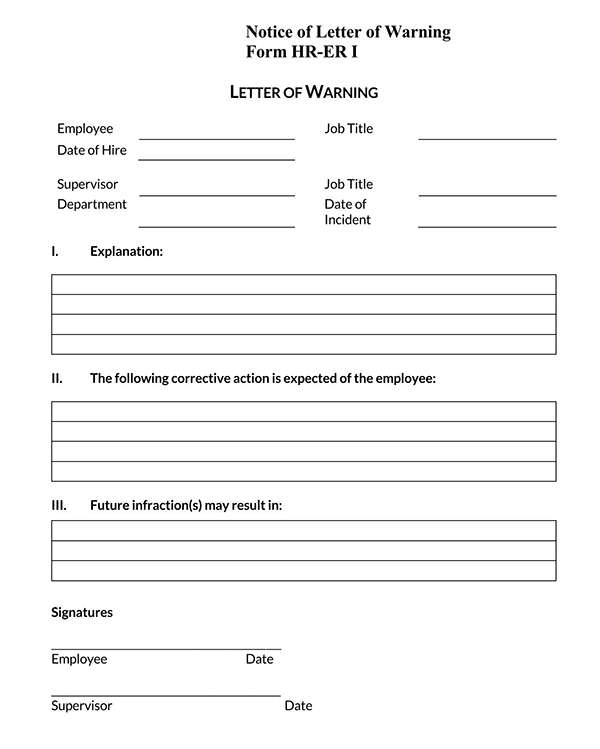
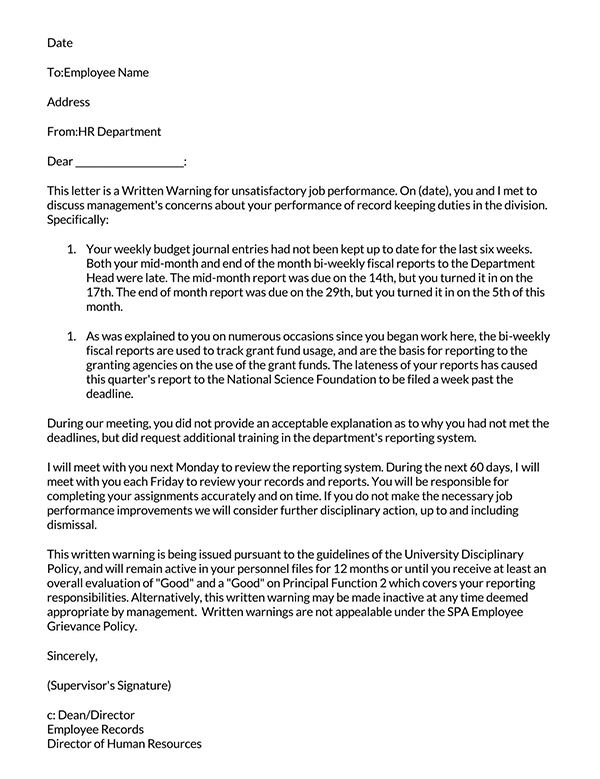
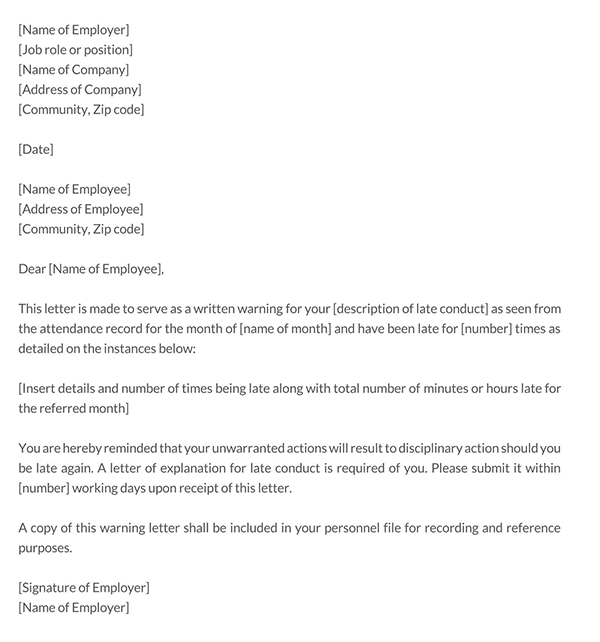
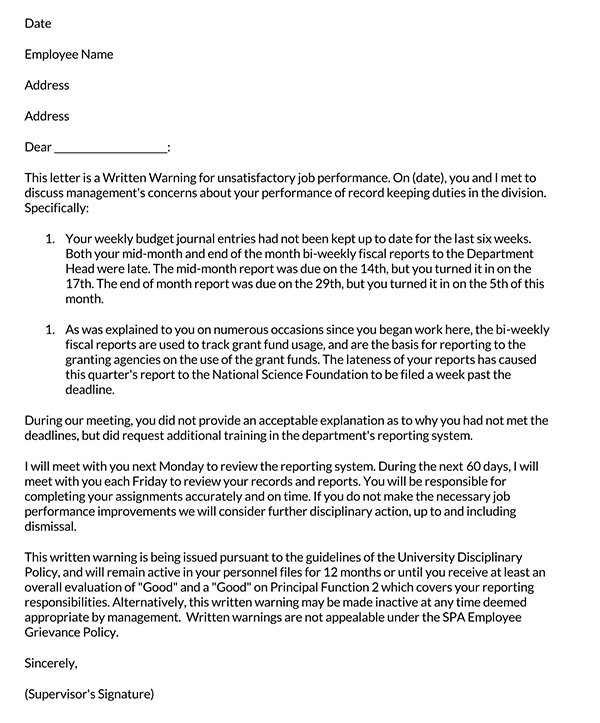
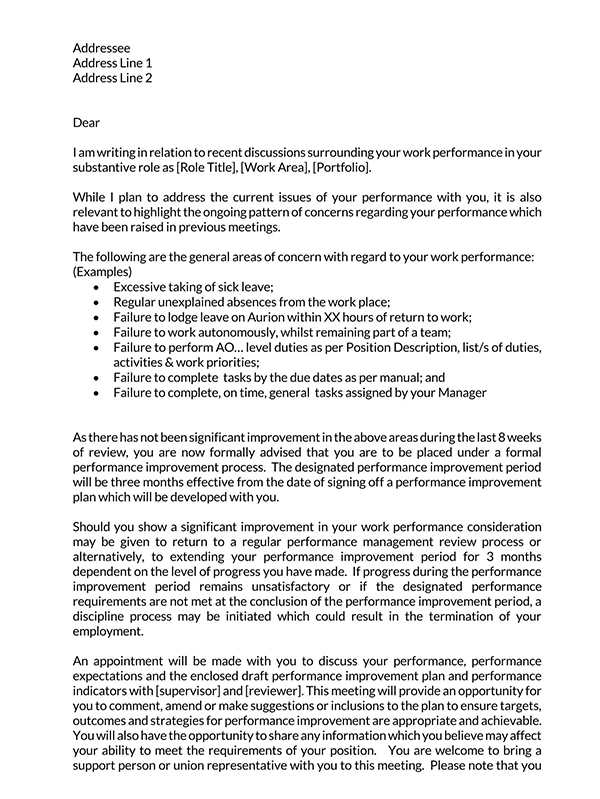
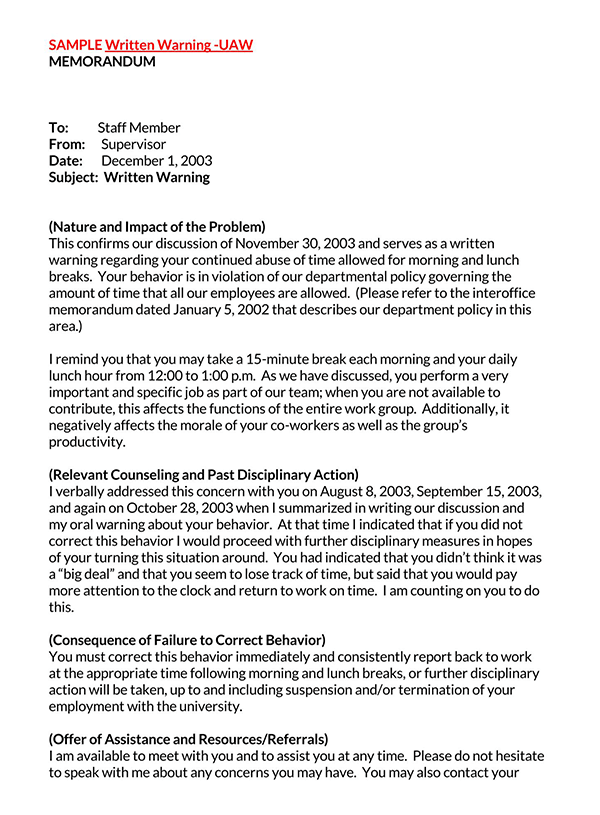
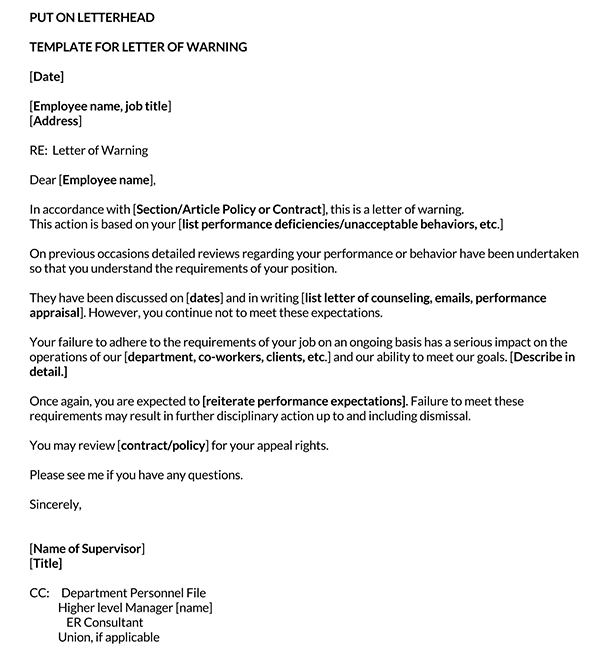
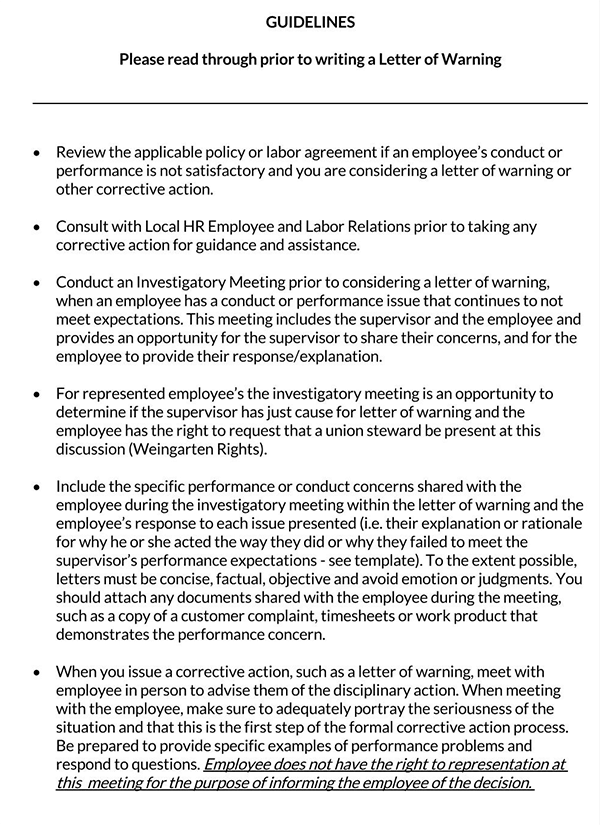
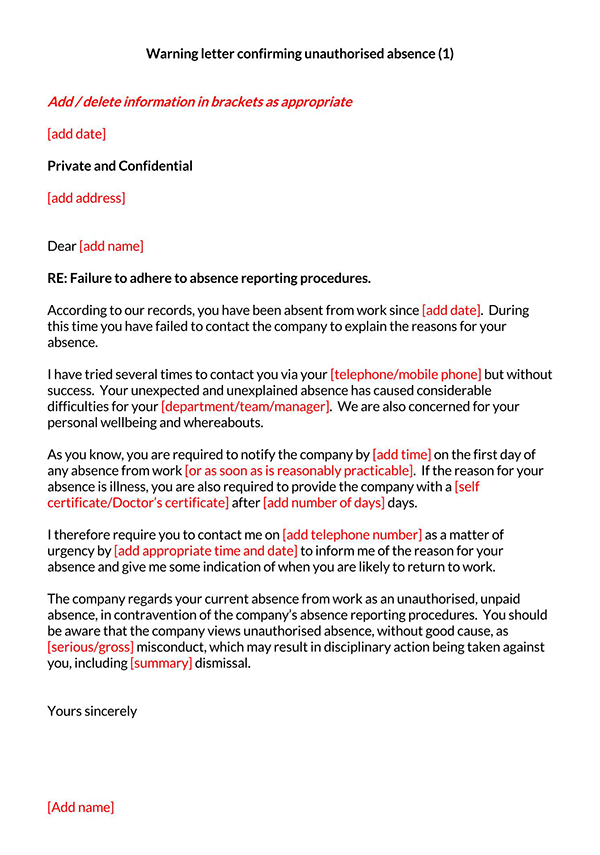
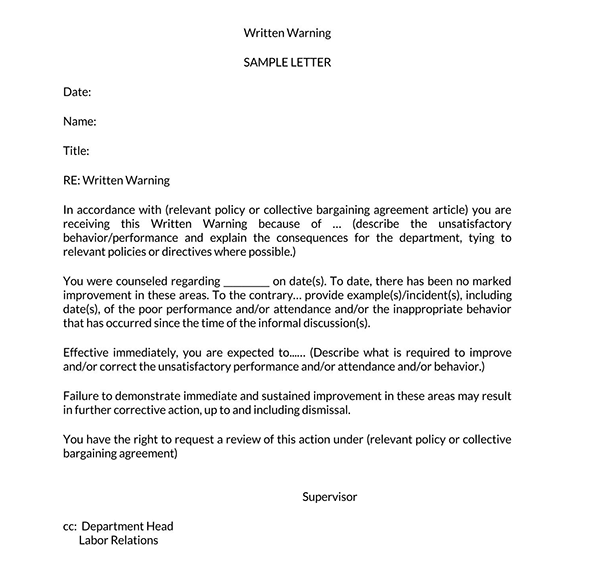
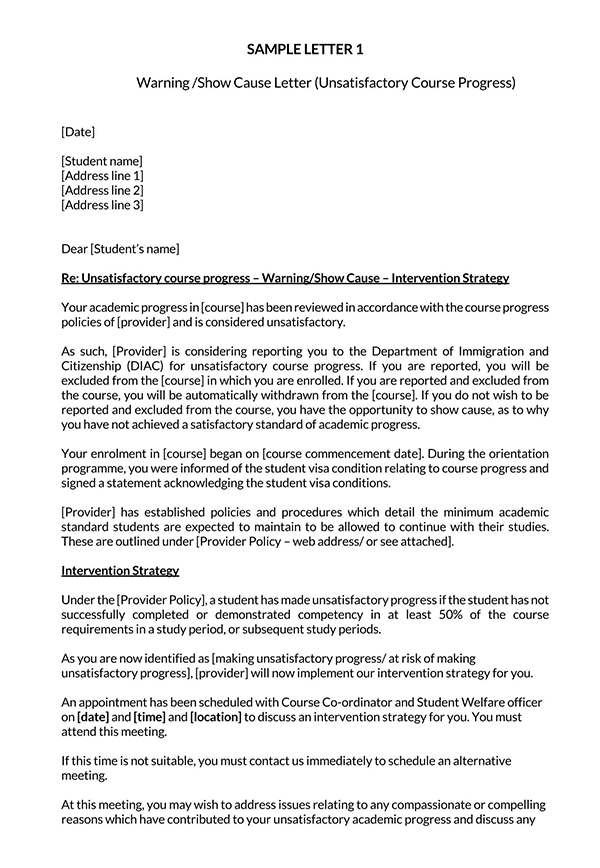
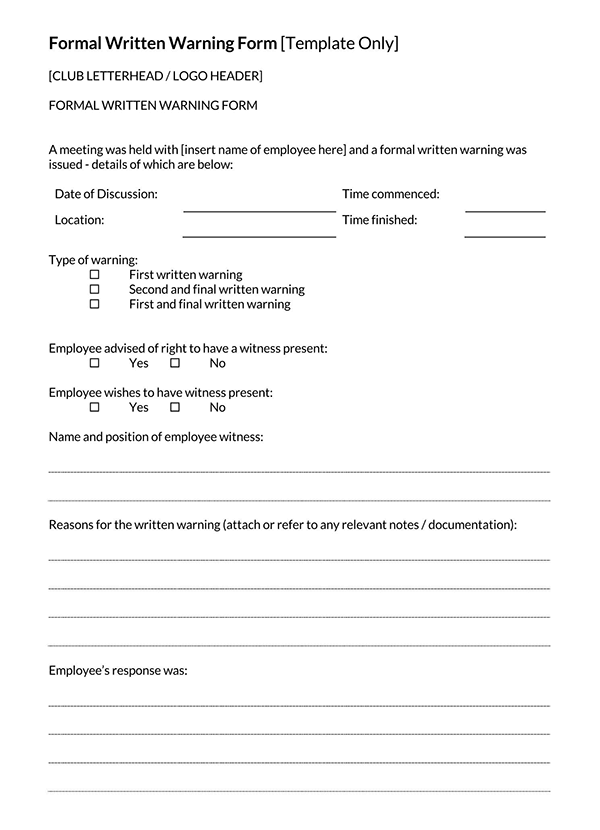
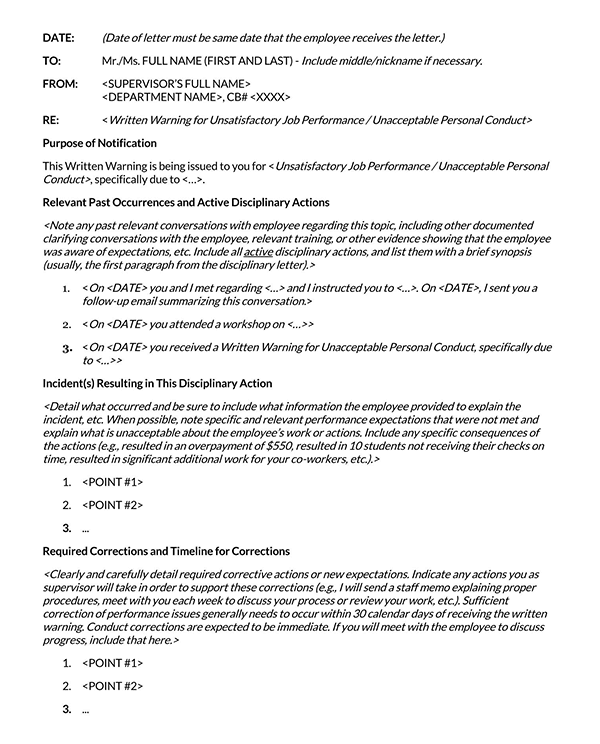
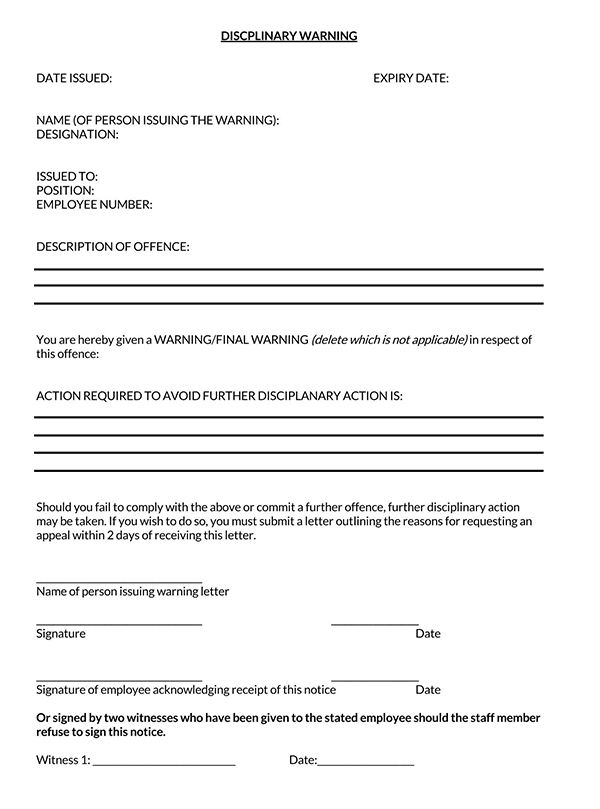
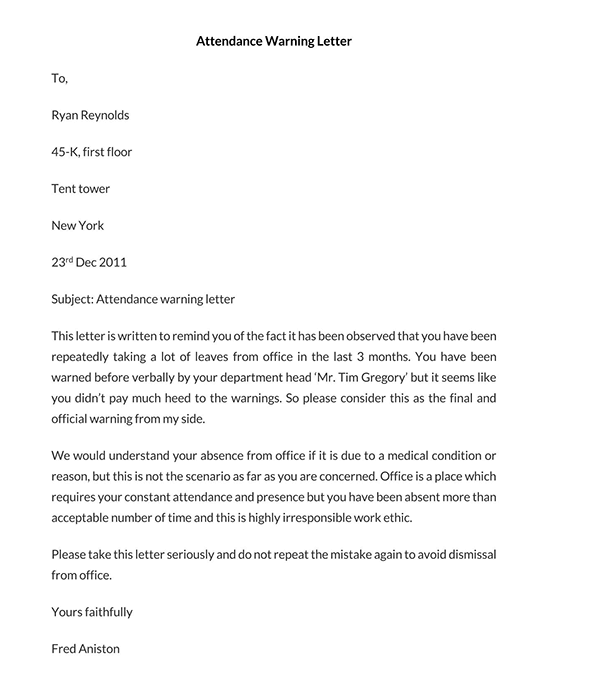
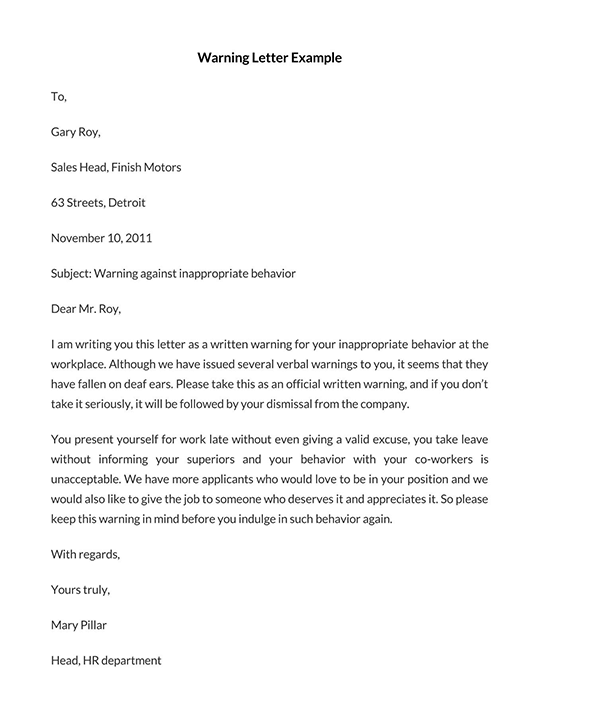
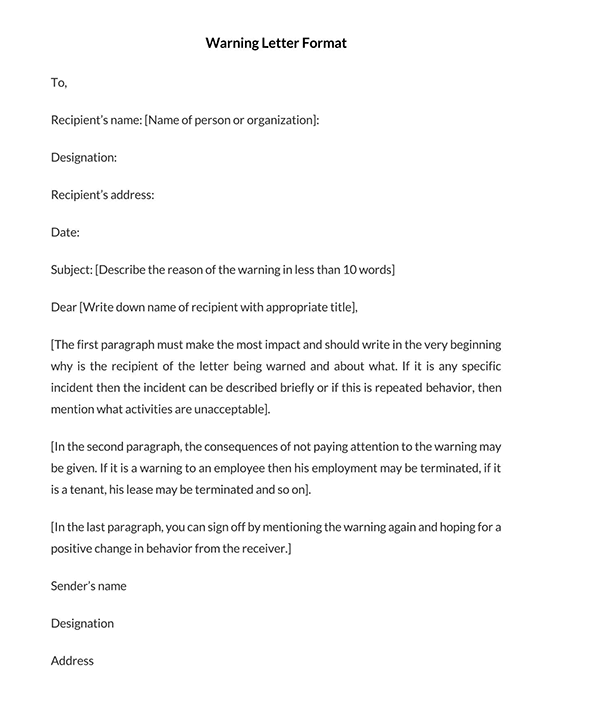
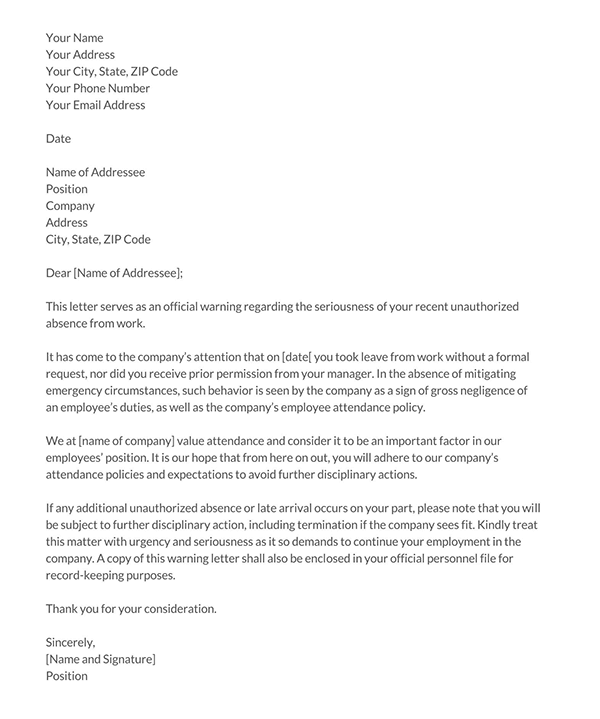
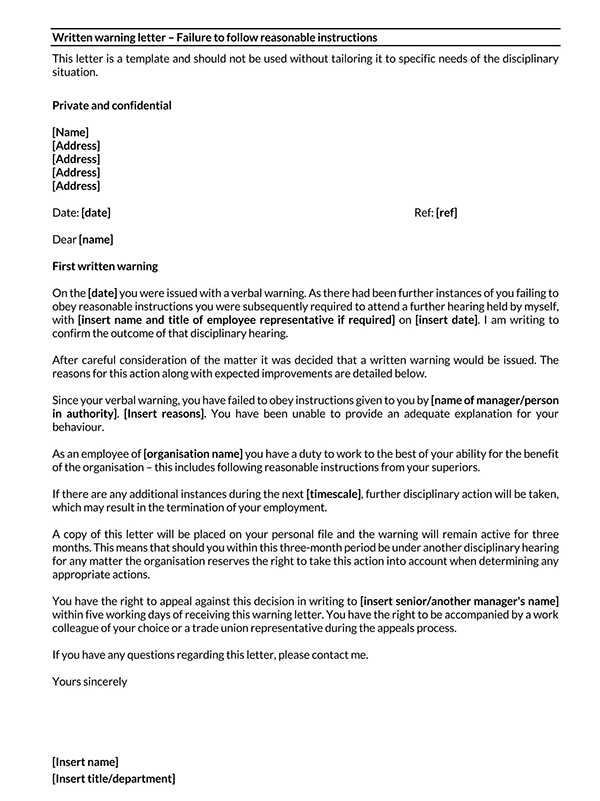
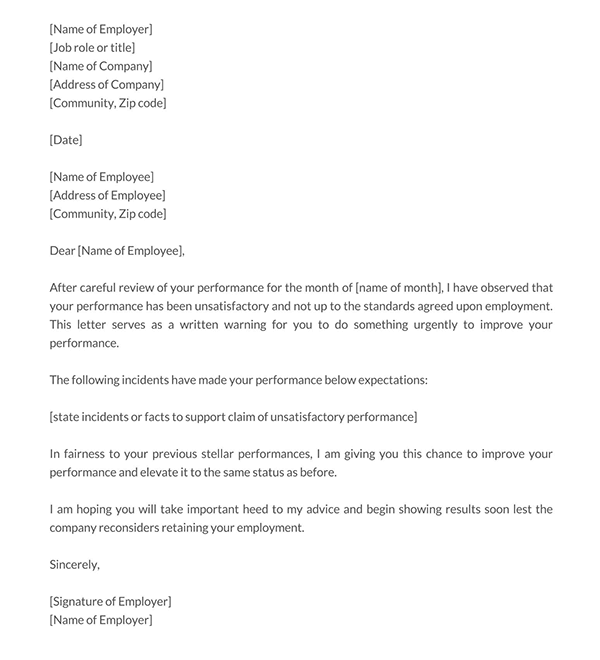
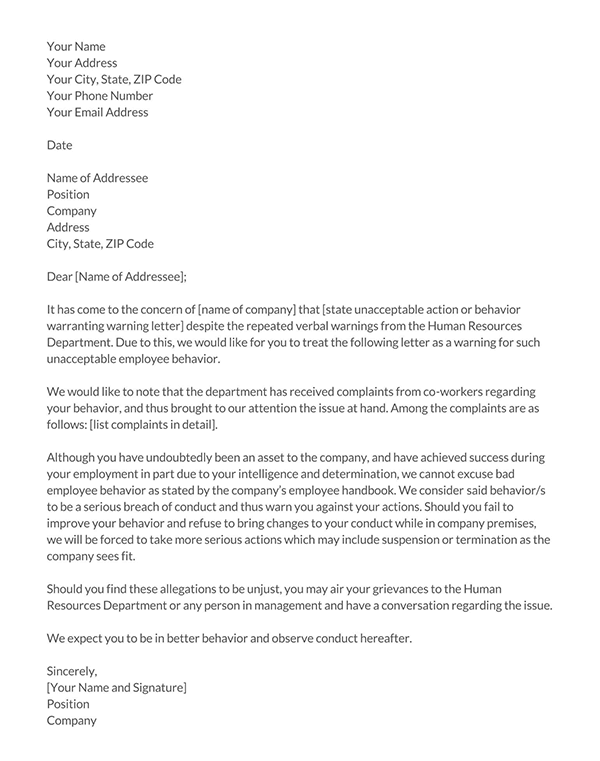
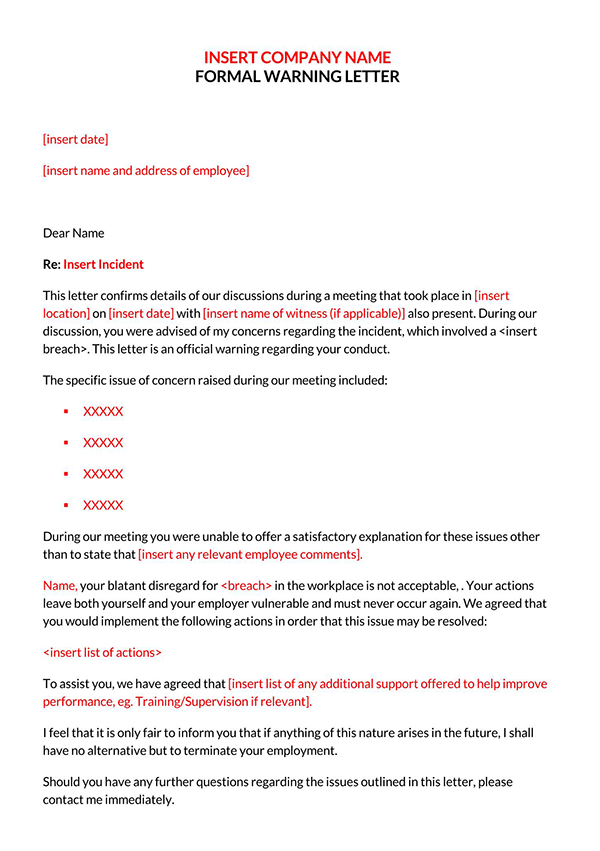
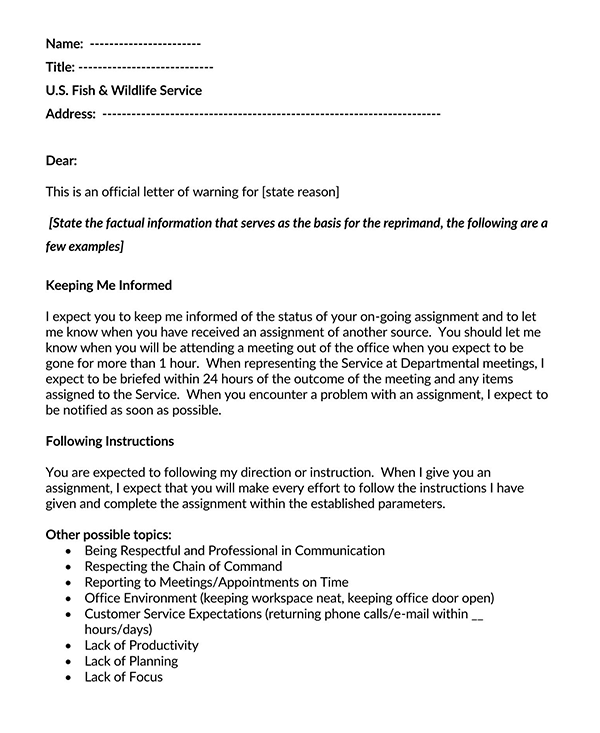
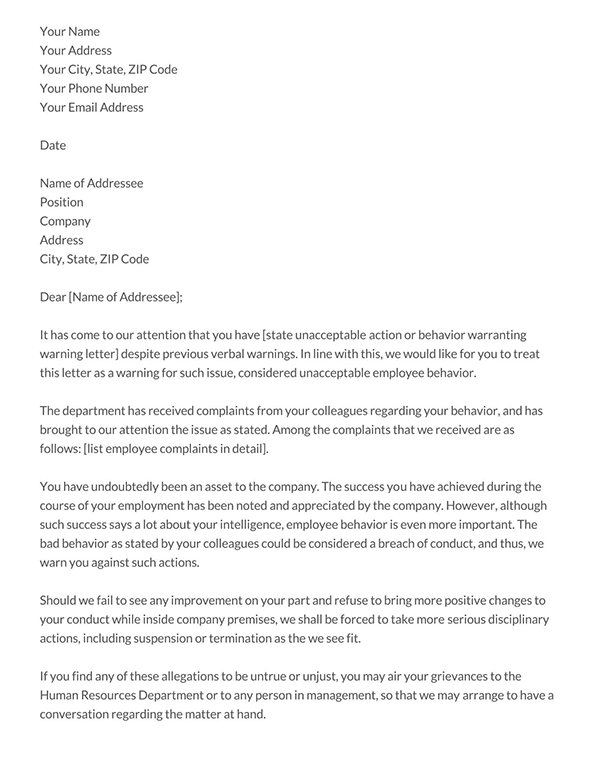
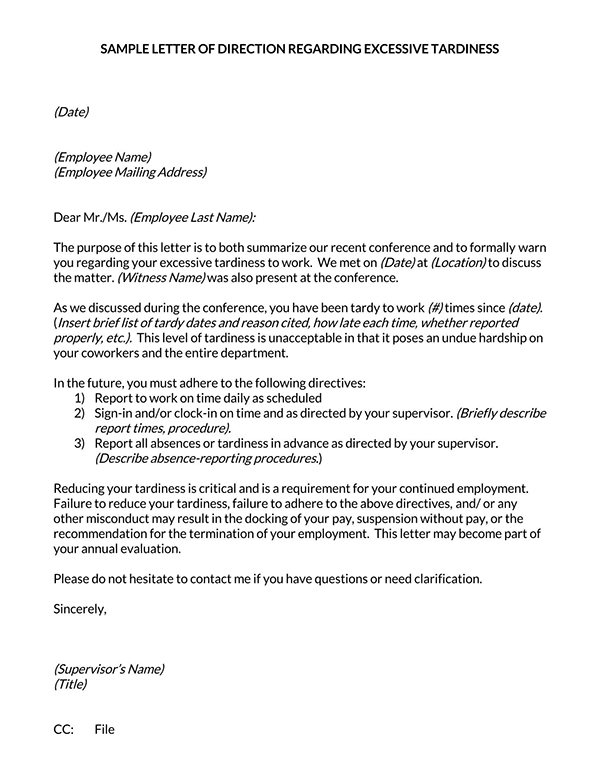
Frequently Asked Questions
An employee may be placed on probation for committing serious offenses at the workplace or for unsatisfactory performance. The employee placed on probation will be issued a written notice of probation, which generally details the reasons for the action, the length of the probationary period, and a corrective action plan that the employee must successfully implement during the probationary period.
During this period, the manager will meet with the employee to review his progress from time to time. Once the disciplinary probation period is over, an employee who does not show satisfactory improvement may be subject to further disciplinary action, which may include suspension or termination of employment.




